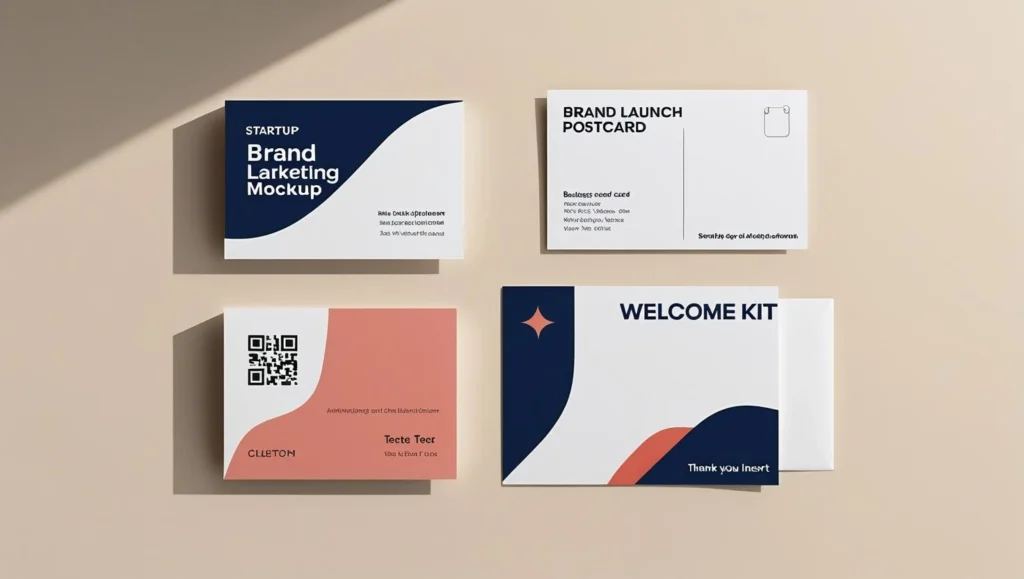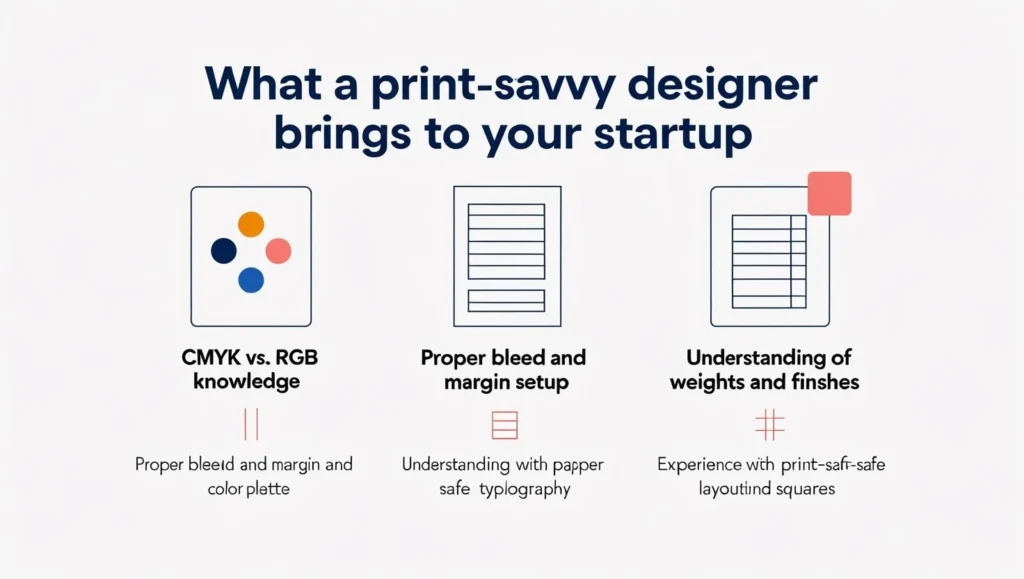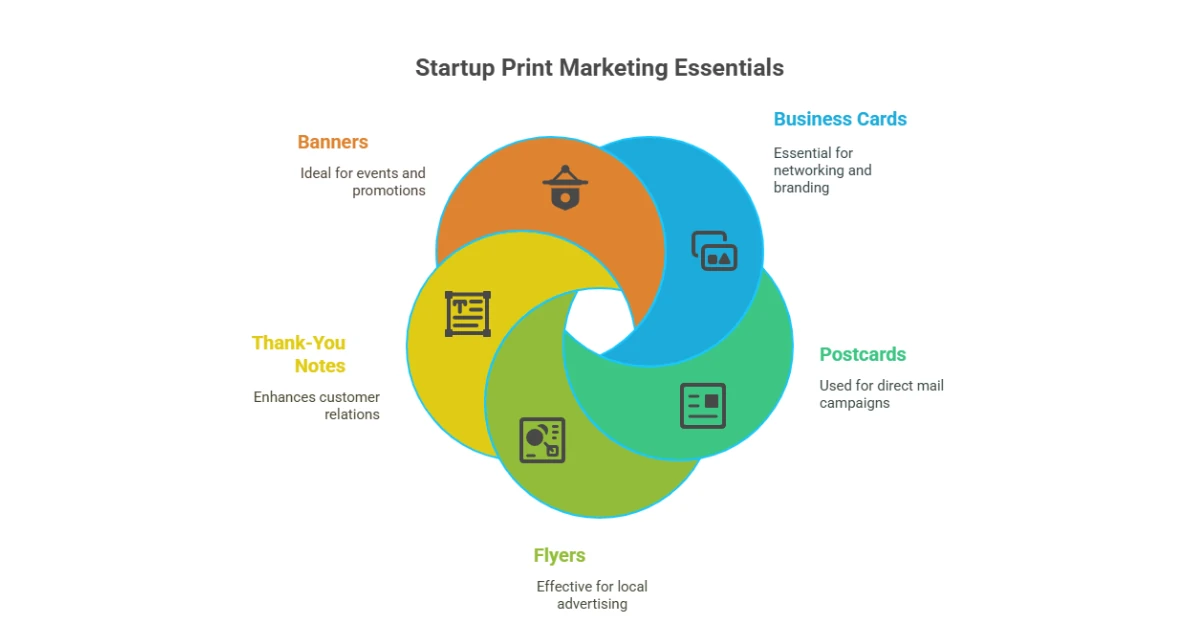TL;DR: Learn which print materials actually help your startup stand out, build trust, and drive real results, without wasting money. This guide covers essential print assets for launches, events, and customer retention, plus design tips and budget-friendly strategies. Whether you’re brand-new or bootstrapping, you’ll walk away with a focused, professional print plan that works in the real world.
Ever printed 500 flyers only to realize nobody wanted them? Yeah, you’re not alone. Startups waste a lot of money on print materials that end up in recycling bins or forgotten in storage. If you’re trying to figure out what print materials are actually worth the investment for a new brand. You’re in the right place.
In this guide, we’ll break down the must-have print assets for early-stage startups, how to design them without breaking the bank, and how to avoid common rookie mistakes. Whether you’re heading to your first pitch event, sending out your first product, or want to look like you’re not running things out of your garage (even if you are), these tools will help.
Table of Contents
Why Print Marketing Still Matters for Startups in a Digital World
Think print marketing is obsolete in the digital-first era? Think again. Despite the dominance of digital advertising and online brand touchpoints, tangible print media continues to provide real-world, sensory experiences that boost brand recall, customer trust, and multi-channel marketing effectiveness.
Tangible Print Materials Build Brand Trust
Handing someone a beautifully designed business card or thank-you card feels different than sending a LinkedIn request. Print is tactile, memorable, and creates a physical anchor for your brand, especially useful when you’re still new and unknown.
For example, one of our clients, a DTC skincare startup, began including printed insert cards in every order. Not only did this boost repeat purchases, but customers also started posting the cards on social media.
Print Design Differentiate Your Startup at Events
At startup expos or networking events, everyone’s handing out QR codes or spamming inboxes. It all starts to blur together. But when someone pulls out a well-designed brochure, a clever pitch card, or a sleek branded folder, people notice. It’s tactile, unexpected, and signals you’ve put real thought into your presentation. Especially when it feels premium, it sends a clear message: your startup takes itself seriously, and so should they.
Pro Tip: Good print collateral makes you look more established than you are — even if you’re still pre-revenue.
Essential Print Marketing Collateral for Startup Growth
Let’s skip the fluff and save you the guesswork. These are the high-impact print marketing materials that actually move the needle for early-stage startups trying to grow, connect, and look legit from day one.
Print Assets for Launching a New Startup Brand
- Business Cards
Still essential, especially when you’re meeting investors, collaborators, or future customers face-to-face. Please keep it clean and readable. Add your name, role, and up-to-date contact info. Use bold typography, consistent brand colours, and quality paper stock. Avoid clutter, but don’t make it so minimal that it lacks personality. A well-designed card makes a strong first impression and reinforces brand credibility long after the meeting ends.
- Brand Launch Postcards
Use these for local mailers, pop-ups, or leave-behinds. Add a bold headline, your core value prop, and one clear CTA like a QR code or signup link. Keep the layout clean, on-brand, and easy to skim. These are perfect for grabbing attention quickly and guiding people to your next step, whether it’s a beta waitlist or landing page.
- Welcome Kits
Launching a product or service? Add thoughtful print inserts like thank-you cards, product tips, or intro notes that show personality. These little touches help customers feel like they’re part of your brand’s journey, not just a transaction.
For example, one early-stage design subscription startup included a minimalist welcome card and sticker inside their first 50 packages, the card featured their brand values and a handwritten thank-you note. This helped build trust and early customer loyalty.

Startup Print Materials for In-Person Events and Networking
- Event Flyers & Posters
These are great for quick, focused messages that grab attention fast. Use bold visuals, clear calls-to-action, and striking headlines that make people stop and look. Think: “Pitch Night at 7 PM” or “Try Our App, Win a Shirt.” Keep it simple but visually magnetic. These are your startup’s voice on walls, windows, or hands.
- Branded Signage or Pop-Up Banners
Invest in a clean, modular banner you can reuse at conferences, pitch nights, or coworking pop-ups. Your signage should instantly tell people who you are and what you do. Make sure your startup logo, tagline, and brand colours are bold and visible from across the room. This helps attract attention, spark conversations and gives your setup a polished, professional edge even if you’re just getting started.
- Pitch Leave-Behinds
Think of these as your startup’s highlight reel on paper. A one-pager or mini brochure that quickly shows your mission, traction, and proof you’re worth paying attention to. Structuring it with user interface design principles like hierarchy, white space, and clarity ensures it’s both attractive and easy to scan.
Include key contact info, core offerings, and a compelling call to action. Hand these out at pitch events or investor meetings to leave a strong impression after the conversation ends.
Visual Note: Include real startup examples of these or templates designed for early-stage companies.
For Customer & Community Engagement
- Thank You Cards
Don’t underestimate the power of a handwritten or beautifully printed thank-you card. These small touches help build emotional connection and trust. Drop them into product shipments, share them with early users, or welcome new hires in style. Thoughtful details leave lasting impressions.
- Stickers & Swag Inserts
People love stickers. They’re fun, low-cost, and full of personality. Use them to spark conversations, decorate laptops, or show off your brand. Toss in a few with your product packaging or at events. They’re small, but they leave a big impact and help your fans spread the word for you.
- Referral Cards or Discount Coupons
These are perfect for turning your early users into brand advocates. Add a unique discount code and a personal message like “Just for our earliest supporters.” It feels exclusive, builds loyalty, and sparks referrals that actually convert. Hand them out at events or slip them into packaging to spread the word with purpose.
How to Make Your Print Materials Look Professional (Without Breaking the Bank)
Print isn’t just about having materials. It’s about looking like you know what you’re doing. Help your brand avoid the rookie mistakes that make startups look unprofessional, like sloppy layouts, flimsy stock, or unclear messaging. Skip the cheap, generic designs and focus instead on building polished, purposeful print assets that reflect your identity, create brand consistency, and show you’re serious about how your startup presents itself.
Keep Your Brand Identity Consistent
Your all print materials should feel like they all came from the same place. From business cards to banners, stick to your brand colours, logo, fonts, and tone of voice, all key elements of a consistent visual identity system. When everything looks aligned, people instantly recognize you, and trust grows faster. Even small startups can feel premium with a consistent look across every touchpoint.
This means using your brand colours, typography, logo placement, and tone across all print collateral, all part of building a consistent visual system aligned with the types of graphic design services your startup actually needs.
Design for Function, Not Just Aesthetics
Your brochure might look cool, but can people actually read it? Can they find your contact info at a glance? Use a clear visual hierarchy with bold headers, legible fonts, and a clean body copy that flows naturally. The same user interface design principles that apply to apps also work wonders in print. Focus on usability first so your message hits home and doesn’t get lost in a pretty design.
Work with a Print-Savvy Designer
Not every designer gets to print. Things like bleed lines, CMYK colour settings, and paper weight aren’t just technical. They affect the final result. So, choose someone who knows how your design will actually look when it leaves the screen and hits someone’s hands.

Tip: If you’re DIYing, use tools like Canva Print or Moo that offer print-safe templates.
Budgeting Tips: How to Prioritize Print When You’re Bootstrapped
Startups usually run lean, and your print budget should, too. Here’s how to create cost-effective, high-impact print marketing that stretches your dollars without sacrificing quality or credibility:
- Start small. Begin with 50 to 100 print pieces and test them in real-world situations. Watch what gets noticed, shared, or tossed. That feedback helps you fine-tune before going big.
- Bundle designs. Repurpose one polished layout across different print formats like flyers, postcards, or inserts to keep your brand consistent and save on design costs.
- Focus on ROI. Invest in the print pieces that actually drive results, like eye-catching business cards, memorable thank-you inserts, and polished event signage that gets your startup noticed, remembered, and talked about.
Three Common Mistakes Startups Make with Print Marketing
You’re not alone if your first print project flopped. Many startups miss the mark at first. Let’s turn that around and get it right.
1. Going Too Cheap
Thin paper, blurry logos, or off-centre margins? People notice. You don’t need to go full luxury, but quality print shows you care. First impressions stick, especially for startups.
2. Printing Without a Purpose
Every printed marketing asset should align with a specific goal: brand awareness, user acquisition, customer engagement, or lifecycle retention. Random print materials without a distribution or conversion strategy dilute impact and waste budget. Be intentional; your startup’s print collateral should earn its place by supporting clear, measurable outcomes.
3. Ignoring Distribution
Having 1,000 flyers sitting in your office won’t move the needle. Make a clear plan to get them into the right hands at events, in mailers, tucked inside product boxes, or waiting on front desks. Your print materials only work when people actually see and engage with them.
Bold takeaway: Your print strategy is only as good as its execution.
Beginner Print Marketing Plan for Early-Stage Startups
If you’re overwhelmed, start with just three essentials:
Startup GoalPrint Materials
Build Credibility Business cards, postcard
Event Presence Flyer, one-pager, banner
Customer Retention Thank-you card, referral card
Once you get feedback, scale up. Track what people respond to, and update your designs as your brand evolves.
Before printing anything, make sure your logo, fonts, and colours are dialed in. Having a defined visual identity system will help you stay consistent across business cards, thank-you notes, banners, and everything in between.
- CTA: Need help designing your first print kit? Work with me to build a startup-ready visual identity that works on paper and screen.
Final Thoughts
You don’t need every print item under the sun. But with the right essentials and smart design, you can make a real impression.
Start with the basics. Test what works. Stay consistent. And never underestimate how powerful a great print piece can be when everyone else is going digital.
FAQs: Print Marketing Materials for Startups
What print marketing materials should every startup begin with?
Start with high-impact essentials: business cards, a simple launch postcard, and a thank-you card. These help you look professional, connect personally, and start building trust. You don’t need a huge print budget.You need just thoughtful design and clear messaging.
How can print marketing help startups stand out at events?
Print materials like flyers, branded banners, and pitch leave-behinds give your startup a tactile, polished edge. While everyone else is sharing QR codes, you show up with something memorable, which helps spark conversations and create lasting impressions.
Are print marketing materials still worth it for digital startups?
Yes. Print adds a physical touchpoint that builds brand credibility and trust, especially for new or digital-first startups. A simple thank-you insert or quality card can make your brand feel more real, personal, and professional from day one.
What’s the best way to design print materials on a tight startup budget?
Stick to multipurpose layouts, use consistent branding, and prioritize quality over quantity. Tools like Canva Print or Moo make it easy to DIY, or work with a designer who understands print fundamentals like CMYK, bleed, and paper weight.
How do I know which print materials are actually working?
tart small (50–100 pieces) and track responses. See what people keep, ask about, or share. For example, if your thank-you cards lead to repeat orders, scale that. Let real-world feedback guide what to improve or print more of
What’s the biggest mistake startups make with print marketing?
Printing without a clear purpose or plan for distribution. Don’t just stockpile flyers — make sure each piece supports a goal (like signups or brand recall) and has a way to reach the right people, whether at events or in product boxes.




